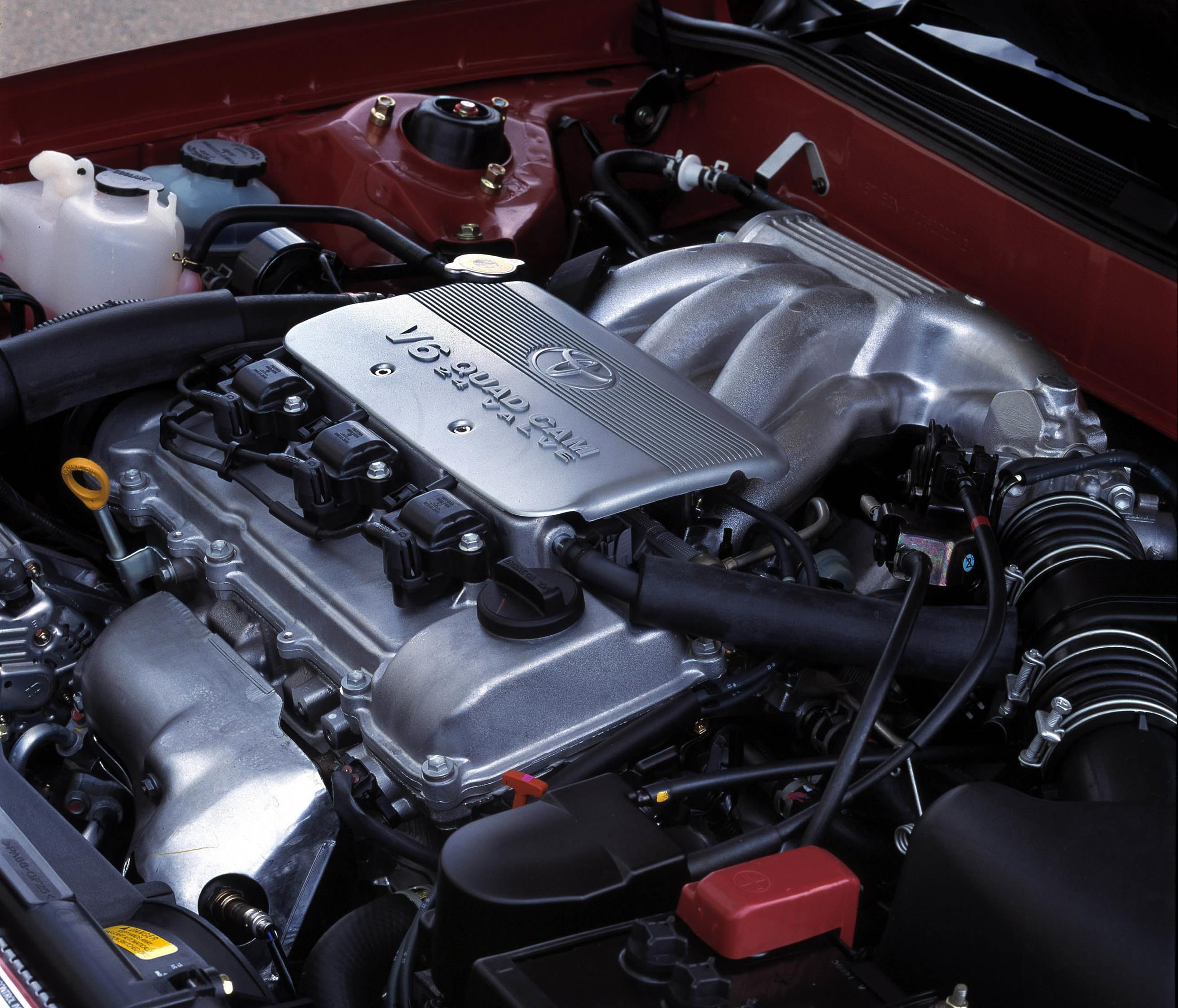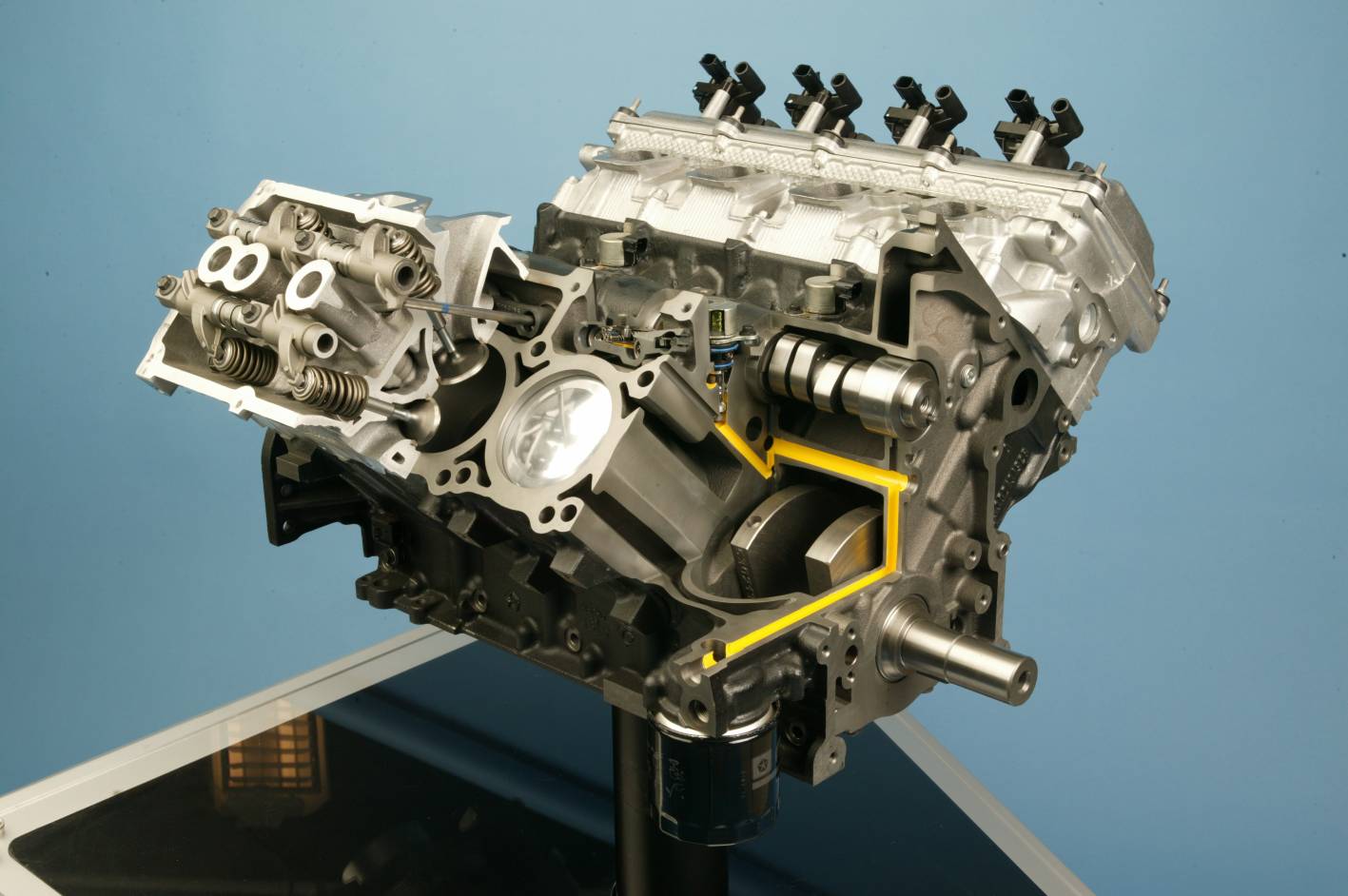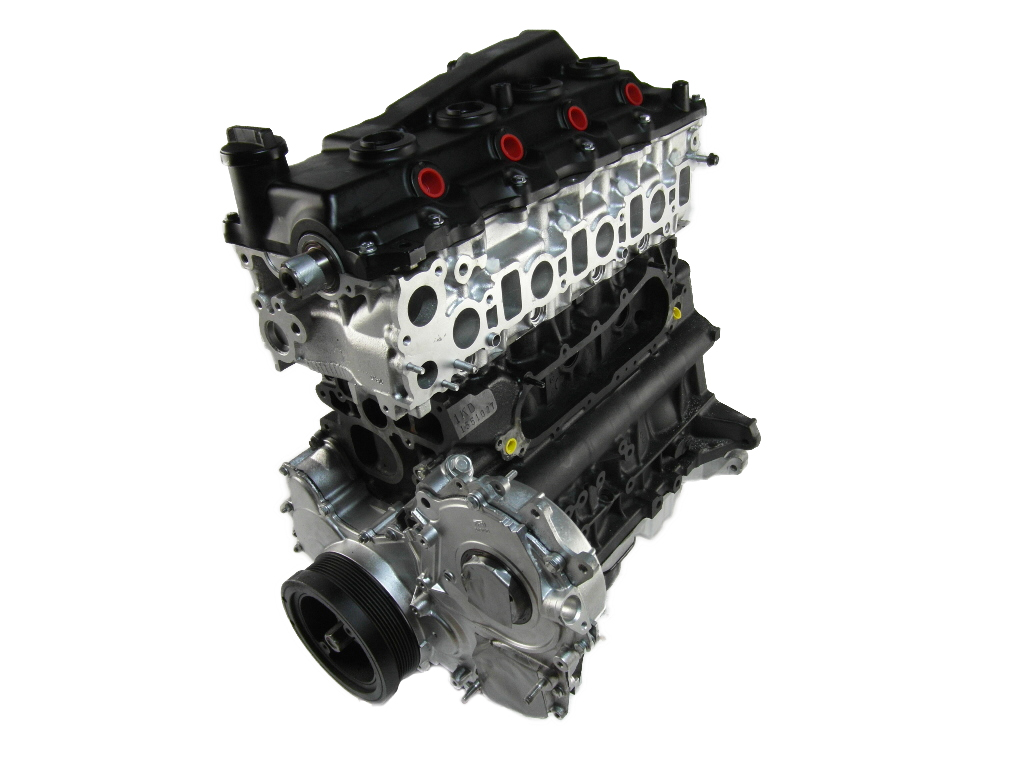Since the N63 provided comparable performance with the N73 V12 engine, the N73 engine was redesigned with twin turbochargers for the F01 760i and F02 760Li.
N63BO0 Engine
N63B44 crankcase
The N63B44 engine had a closed-deck, aluminium-silicon alloy (Alusil) crankcase with with double main bearing bolting and additional side wall mounting. The cylinder walls were hardened through exposure honing – a ‘soft stripping’ process that removed the aluminium from the cylinder surface such that hard silicon particles remained. Furthermore, the N63 engine had a cast-iron crankshaft with five main bearings, fracture-split forged connecting rods and cast aluminium alloy pistons.
N63B44 cylinder head
The N63B44 engine had an aluminium alloy cylinder head in which the positioning of the intake and exhaust manifolds were switched such that the exhaust manifold was located between the cylinder banks and the intake manifold on the outside of the engine. As a result, the turbochargers and the main near-engine catalytic converters could be positioned between in engine’s ‘V’ (i.e. between the cylinder banks). The N63 was the first engine to use this packaging, which provided a more compact design and reduced the distance from the exhaust manifolds to the turbochargers.
The N63 engine had double overhead camshafts per cylinder bank that, like the M73 engine, were produced by fusing sintered metal camshaft lobes to a hollow metal shaft. The camshafts were driven by a newly developed tooth-roller chain and featured BMW’s double VANOS system. For the N63, the vanes of the VANOS units formed an oscillating rotor and provided 50 degrees of adjustment for both the intake and exhaust camshafts. For the N63 engine, the exhaust camshafts for cylinders 2, 4, 7 and 8 produced a different valve lift curve than for cylinders 1, 3, 5 and 6. Furthermore, the exhaust valves of cylinders 2, 4, 7 and 8 opened later, had a shorter opening period and less valve lift for smoother running. The N63B44 engine did not have BMW’s Valvetronic variable intake valve lift system.
For lubrication, the N63 engine had a volumetric flow-controlled oil pump that was driven by the crankshaft.
Turbochargers
The N63B44 engine had two relatively small, parallel-connected Garrett MGT2256ST turbochargers. Boost pressure was controlled by wastegate valves that were operated by vacuum units and controlled by electropneumatic pressure converters (EPDW) via the engine management system. When the desired level of boost pressure was attained, the wastegate valve would open and direct part of the exhaust-gas flow past the turbine wheel. At full load, the turbochargers provided peak boost pressure of 0.8 bar (in the intake manifold). The N63B44 engine also had diverter (blow-off) valves that could reduce unwanted peaks in boost pressure which could occur when the throttle valve was closed quickly.
The N63B44 engine had indirect charge air cooling with two water-cooled intercoolers that were mounted on the engine. Significantly, the charge air heated in the turbocharger and by compression was cooled in the intercooler by up to 80 degrees Celsius.
Injection and ignition
Previously introduced in the N54, the N63B44 engine had High-Precision Injection (HPI) which used outward-opening Piezo-electric injectors that were integrated with the spark plug and positioned between the inlet and exhaust valves in the top of the combustion chamber. Fuel delivery pressure was controlled by the MSD85 engine management system, though the maximum pressure of 200 bar was only required for high loads at low engine speeds.
The N63B44 engine had a compression ratio of 10.0:1 and 98 RON premium unleaded petrol was recommended. Furthermore, the firing order was 1-5-4-8-6-3-7-2.
N63TU or N63B44O1TU Engine
Compared to the N63B44O0, the N63B44O1 (or N63TU) engine introduced the following changes:
- High-pressure injection replaced the previous High-Precision Injection (HPI) system. High-pressure injection differed in that it used Bosch high-pressure solenoid valve injectors (HDEV5.2), as previously introduced in the N55 and N20 engines. Unlike the outward-opening piezo injectors of the HPI injectors, the HDEV5.2 injectors were inward-opening, multi-hole valve injectors which had high variability for spray angle and spray shape. Maximum injection pressure remained at 200 bar, while the high pressure fuel lines from the rail to the injector were no longer bolted at the rail end, but welded as per the N20 engine;
- A new cylinder head for the BMW’s ‘Turbo Valvetronic Direct Injection’ system which included the third generation variable intake valve lift system known as ‘Valvetronic III’. Although previously introduced on the N55 engine, the Valvetronic servo motor for the N63TU engine was mounted on the outer side of the cylinder head;
- The VANOS system from the N55 engine was adopted. As such, the adjustment range of the intake camshaft was increased from 50 degrees to 70 degrees through the use of four flanks instead of five, while exhaust camshaft adjustment increased from 50 degrees to 55 degrees. The camshaft chain drive also had modified tensioning, guide and slide rails;
- The compressors for the turbochargers had nine blades of the same size (previously, double blades with five large and five small blades were used), while the wastegate valves were also modified;
- The blow-off valves were discontinued due to the use of Valvetronic, special tuning and turbocharger upgrades;
- The weight of the crankshaft was optimised;
- New connecting rods with even pitch (previously diagonal) and 60g lighter pistons with modified crown geometry; and,
- The MEVD17.2.8 engine management system and hot film air mass meter 7.
S63 Engine
The S63B44O0 was BMW Motorsport’s version of the N63 and used in the E70 X5 M and E71 X6 M. Compared to the N63 engine, the S63 engine had the following changes:
- Twin-scroll turbochargers with a pulse-tuned exhaust manifold which connected both cylinder banks. In an ideal configuration, the exhaust gas pulses from cylinders 1/6 and 4/7 were fed to the turbocharger installed over the right bank (cylinders 1-4) and the exhaust gas pulses from cylinders 2/8 and 3/5 were fed to the turbocharger installed over the left bank (cylinders 5-8);
- Maximum boost pressure was increased to 1.2 bar (from 0.8 bar);
- Upgraded pistons and a lower 9.3:1 compression ratio (previously 10.0:1);
- The cylinder head was made from a higher grade alloy to accommodate the higher thermal and mechanical loads, modified turbochargers and exhaust manifold;
- Within the crankcase ventilation system, the oil separator and control valve were adapted;
- New exhaust camshafts with different timing;
- Valve lift increased to 9.0 mm (from 8.8 mm);
- Maximum engine speed increased to 6800rpm (6500rpm);
- MSD85.1 engine management;
- An upgraded cooling system which included an additional intercooler heat exchanger installed in series, a second auxiliary water pump and a new expansion tank. Also,
- the length of the engine intercoolers was increased from 130 mm to 160 mm; and,
- the transmission oil heat exchanger was adapted to the higher engine output by increasing the number of plates from 23 to 31.
S63B44T0 or S63TU Engine
The S63B44T0 engine was first introduced in the F10 M5 in 2011 and was a successor to the S85 engine. For the S63B44T0 engine, the ‘T’ stood for ‘Top performance class’, though this engine was also referred to as the ‘S63 top’ and S63TU (‘TU’ for technical update).
Rather than increasing power outputs, the primary objectives of the S63B44T0 were to increase engine response and rev characteristics while reducing fuel consumption. The S63B44T0 engine incorporated some of the changes that were introduced on the N63TU engine and, compared to the S63B44O0, changes included:
- A new cylinder head with BMW’s ‘Turbo-Valvetronic Direct Injection’ (TVDI). Incorporating BMW’s third generation variable intake valve lift system, Valvetronic III, the S63B44T0 was the first BMW M engine to feature Valvetronic;
- New variable camshaft timing control (VANOS) which increased intake camshaft adjustment 70 degrees (from 50 degrees) through the use of four flanks (previously five), while exhaust camshaft adjustment increased to 55 degrees (from 50 degrees);
- A new crankshaft;
- New Mahle cast pistons and new connecting rods with even pitch;
- Maximum boost pressure increased to 1.5 bar (previously 1.2 bar);
- The compression ratio increased to 10.0:1 (previously 9.3:1);
- Maximum engine speed increased to 7200rpm (previously 6800rpm);
- New oil spray nozzles; and,
- The introduction of DME MEVD17.2.8 and hot film air mass meter 7.
| Engine | Capacity | Power | Torque | Models | Years |
|---|---|---|---|---|---|
| N63B44O0 | 4395 cc (89.0 x 88.3) |
300kW at 5500-6400rpm | 600Nm at 1750-4500rpm | F01 750i, F02 750Li | 2008-12 |
| E71 X6 xDrive50i | 2008-13 | ||||
| E72 X6 ActiveHybrid | 2009-13 | ||||
| F07 550i | 2009-12 | ||||
| E70 X5 xDrive50i | 2010-13 | ||||
| F10 550i | 2010-13 | ||||
| F12 650i and F13 650i | 2011-12 | ||||
| N63B44O1 TU | 4395 cc (89.0 x 88.3) |
330kW at 5500-6000rpm | 650Nm at 2000-4500rpm | E71 X6 xDrive50i* | 2013 |
| F01 ActiveHybrid7 | 2010-15 | ||||
| F07 550i | 2012-on | ||||
| F06 650i | 2012-on | ||||
| F12 650i and F13 650i | 2012-on | ||||
| F01 750i and F02 750Li | 2012-15 | ||||
| F10 550i and F11 550i | 2013-on | ||||
| F15 X5 xDrive50i | 2013-on | ||||
| S63B44O0 | 4395 cc (89.0 x 88.3) |
408kW at 6000rpm | 680Nm at 1500-5650rpm | E70 X5 M | 2009-13 |
| E71 X6 M | 2009-13 | ||||
| S63B44T0 | 4395 cc (89.0 x 88.3) |
412kW at 6000-7000rpm | 680Nm at 1500-5750rpm | F10 M5 | 2011-on |
| F12 M6 and F13 M6 | 2012-on | ||||
| 423kW at 6000-7000rpm | 680Nm at 1500-6000rpm | F10 M5** | 2013-on | ||
| F12 M6 and F13 M6** | 2013-on | ||||
| S63B44T2 | 4395 cc (89.0 x 88.3) |
423kW at 6000-6500rpm | 750Nm at 2200-5000rpm | F15 X5 M | 2015-on |
| F16 X6 M | 2015-on |
**with Competition Package
N63 Customer Care Package
In December 2014, BMW USA issued service bulletin SI B00 13 14 for the following models that were powered by its N63B44O0 engine:
- F01 750i and F02 750Li vehicles that were manufactured from March 2009 to June 2012;
- F04 Active Hybrid 7 vehicles that were manufactured from April 2010 to June 2012;
- F07 550i Gran Turismo vehicles that were manufactured from September 2009 to June 2012;
- F10 550i Sedans that were manufactured from March 2010 to July 2013;
- F12 650i Convertibles that were manufactured from March 2011 to July 2012;
- F13 650i Coupes that were manufactured from July 2011 to July 2012;
- E70 X5 xDrive50i vehicles that were manufactured from March 2010 to June 2013; and,
- E71 X6 xDrive50i vehicles that were manufactured from July 2008 to June 2014.
Aspart of the campaign, the following items were to be inspected and replaced if necessary:
- Timing chains (if stretched);
- Fuel injectors;
- Mass air flow sensors;
- Crankcase ventilation lines;
- Battery;
- Engine vacuum pump; and,
- Low pressure fuel sensor.
Furthermore, the oil service interval was reduced to 12 month/10,000 miles (previously 2 years/15,000 kilometres).
The above inspections and replacements were to be performed at no cost to the owner, while the ‘N63 Customer Loyalty Offer’ provided incentives for owners affected by the campaign to trade-in their N63-powered vehicle.


















